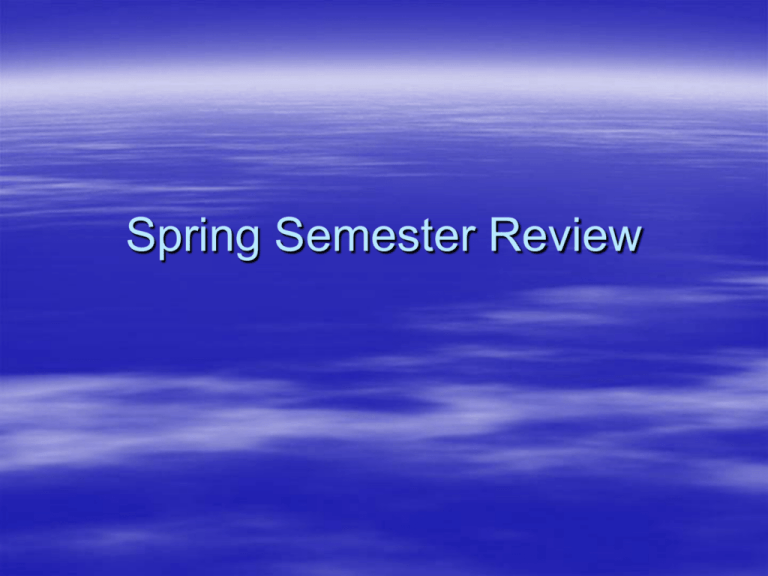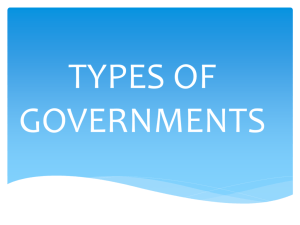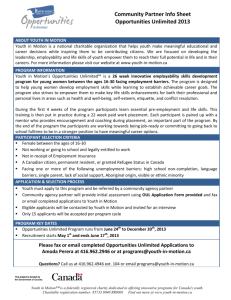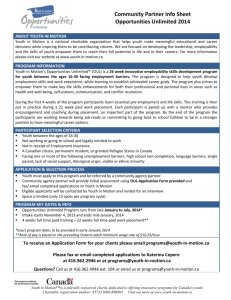Spring Semester Review
advertisement

Spring Semester Review What was the cause of World War I in Europe? – Assassination of Austrian Archduke Franz Ferdinand Which of the following were political effects of World War II? Iron Curtin Great Wall Marshall Plan Bombing of Pearl Harbor Formation of NATO European Union Warsaw Pact What countries were considered the major “Axis Powers” during WWII? The “Allied Powers”? – Axis- Germany, Italy, Japan – Allies – Soviet Union, France, UK, US Differences in governments following World War II resulted in a Cold War between… – USSR & USA The fact that Many African nations today speak European languages such as French is a result of what? – European colonization of Africa Fidel Castro – Cuban Communist dictator Mao Zedong – 1st Communist leader of People’s Republic of China Mohandas Gandhi - nonviolent leader of Indian independence from Britain Nelson Mandela – president of South Africa & symbol of apartheid system Siddhartha Gautama – founder of Buddhism Adolf Hitler – Fascist leader of Germany in WWII who planned the Holocaust Martin Luther – German monk who translated the first bible from Latin to German & Father of the Protestant Reformation Physical Regions – ex – Himalaya Mountains, Serengeti Plain Political Regions –ex Alice Springs, Australia Cultural Regions – areas of world were people share culture traits; ex Latin America, East Asia Climate Zones – areas with similar temperatures and weather patterns Chronological map – sequential by date Political map - shows political divisions ex countries Physical map – shows physical landforms Thematic map – Shows a theme ex: population density or religions Northern Hemisphere North America Europe Asia Africa South America Australia Antarctica Southern Hemisphere Eastern Hemisphere Western Hemisphere Australia - 30° S, 140° E India - 20° N, 80° E South Africa - 30° S, 20° E China - 30° N, 120° E How are relative location and absolute location different? – absolute location is exact, relative location is in relation to another location What is the main difference between different map projections? – Size of continents in relation to each other What are landforms? Give examples – Physical features Ex: mountain, peninsula, isthmus What is a physical/transportation barrier and list examples – Natural barriers that block movement/transportation – EX: Mountains, Deserts, and Oceans Which information is needed to determine population density? - Population & size of area List the 5 largest countries in the world: – Russia; Canada; USA; China; Brazil What is the relative location of Europe from North America? – East Why were many ancient civilizations and many major cities still today near major sources of water? – Transportation and Irrigation Why do people choose to live in high density areas? – Resources, industry, economics. What geographic factors influence people’s migration from one region to another? – Rivers, irrigation, climate 1. 2. 3. 4. 5. What are the Five Themes of Geography? Give an example of each Location – Where it is Region – What is it similar too Place - Characteristics such as climate, soil, land use Movement - Who and what have come and gone Human-Environment Interaction - How people have changed and been changed by the natural world What is a metropolitan area? – A large city, its surrounding suburbs, and other neighboring communities Which geographic factors might discourage the settlement of societies past and present? – Desert, Mountains Why is there not much population in Northern Russia? – Because it is very cold. As a result of the Industrial Revolution, why did European nations begin to compete for control of Africa? – Natural Resources. What geographic factor played a key role in the creation of the EU? – Relative location Which developments in technology have helped people better adapt to their environment? – Tools, equipment, iron plows, irrigation, knowledge of agriculture. Match the economic system description with the correct name: Determined by social and cultural customs. Allocation of resources, goods, and services may be determined by local leaders. – Traditional Economy Government control of resources, production, and pricing. – Command Economy Supply and demand determines price and production. There is very little government intervention. Entrepreneurship is encouraged. – Market Economy Type of economy in… China, Cuba, and North Korea? – Command USA, Canada, UK, and Germany? – Free Enterprise GDP, literacy rates, mortality rates, and life expectancy are all… – Economic Indicators Which of the following is MOST likely to cause the price of taco to increase? – The cost of beef, lettuce and tomatoes goes up. The four factors of production are? – Human Resources, Natural Resources, Capital Resources, Entrepreneurs. How is a Limited Government different from an unlimited government? – In a limited government everyone even the leaders must obey the laws. In an unlimited government the leader does not have to follow the laws. Limited or Unlimited Governments? Japan – Limited China – Unlimited Myanmar – Unlimited Iran – Unlimited UK – Limited USA – Limited India – Limited Vietnam – Unlimited North Korea – Unlimited Constitutional Monarchy – Limited Republic – Limited Democracy – Limited Dictatorship – Unlimited Communism - Unlimited Democracy – Etymology: Demos (people) and kratos (power). A form of government in which ruling power is in the hands of the people. TyrannyEtymology: tyrannos (usurper with supreme power). A form of government in which ruling power is in the hands of a person who has gained power by promising the poor people that he will do good things for them, so they will support him. MonarchyEtymology: Monos (single) and arkein (rule). A form of government in which ruling power is in the hands of one person who retains his power for life. OligarchyEtymology: Oligos (few) and arkein (rule). A form of government, which ruling power is in the hands of a few powerful people (usually the wealthy upper class.) Republic– a form of government in which people rule through elected representatives. Communism– an economic and political system in which property is owned collectively and labor is organized in a way that is supposed to benefit all people. FascismThis form of government headed, in most cases, by a dictator. It involves total government control of political, economic, cultural, religious, and social activities. DictatorshipA government whose leader has complete control over a country’s government. Constitutional MonarchyA government headed by a king or queen who has little or no political power. The real power lies with a governing body of elected representatives and headed by a Prime Minister. The ancient Greek and Roman civilizations helped influence the United States system of government. Direct democracy originated in ancient Greece. Republican democracy originated in ancient Rome and was adopted in the 1700s by the United States. What are the responsibilities of US citizens? Pay taxes, cast an informed vote, serve on juries, obey laws, serve in the military, and volunteer for activities that promote the common good - Similarities of Judaism, Christianity, and Islam: Monotheistic (believe in one god) Originated in the Middle East Christianity and Islam are descended from Judaism and share much of the same scripture - See Israel (Jerusalem in particular) as a holy land - Differences: - Religions are different ages (Judaism, then Christianity, last Islam) - Each religion has a unique holy book - List similarities of Hinduism and Buddhism: believe in Karma Reincarnation originated in India - List differences: - Eightfold path (only Buddhism) - Four Noble Truths (only Buddhism) - Polytheistic (only Hinduism) Region 1 = North Korea Region 2 = South Korea Governments, economics, education, and religion are all organizational structures found… - in every culture and society. - The democratic governments are: India Mexico South Africa Every country has laws and a way to govern itself. Government is the people and groups within society that have the authority to make laws. Exchange of money, goods, and/or services are all economic characteristics common to all societies. How can you tell how well a country’s economy is doing? - A country’s economy is measured by how it’s GDP changes over a period of time (usually a year) Put the following countries in order by GDP: - USA, China, Japan, Germany - Five ways culture spreads are: Conquest Exploration Globalization Technology Trade Which is an example of a culture trait? - Technology - Primary Source or Secondary Source? Diary: primary SS textbook: secondary Political cartoon: secondary Artifact: primary Photograph: primary Dictionary: secondary Government database: primary Biography: secondary Autobiography: primary Atlas: secondary What seems to be the relationship between countries’ Literacy Rate and its Life Expectancy? Why? - The higher a country’s Literacy Rate, the higher its Life Expectancy. Generally the better the education system (more people can read), the better the healthcare (people live longer). - Which group of dates is arranged in correct chronological order? B) 345 B.C. 10 B.C. 245 A.D. 1245 A.D. Primary Industry: takes natural resources from the earth - Logging, mining, fishing, agriculture (farming) Secondary Industry: makes products using natural resources - construction, factories, processing plants Tertiary Industry: sells a product or provides a service - restaurants, supermarket, schools, hospitals Quaternary Industry: gathers information then provides it to support other levels of industry - research, survey companies, news, entertainment





